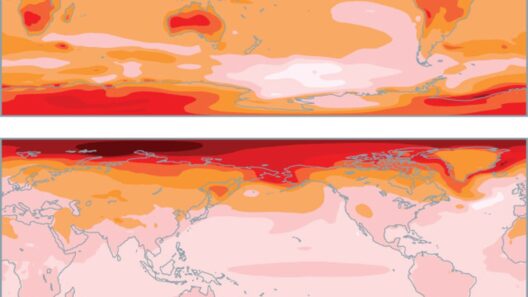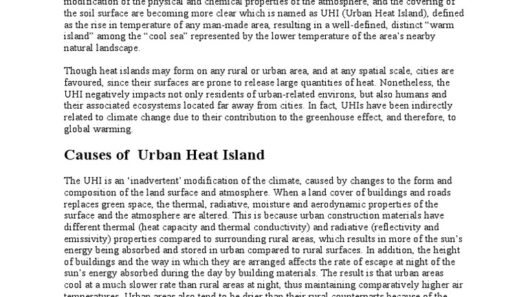When pondering the intricate patterns of global warming, one might whimsically ask, “Which is heating up faster, our expansive oceans or the land beneath our feet?” This conundrum invites scrutiny into the diverse dynamics of climate change, as it presents a challenge that spans across both geographical realms. Understanding the rate of temperature rise over land and sea is not merely an academic exercise. This exploration is crucial for comprehending the multifaceted repercussions of climate change on ecosystems, weather patterns, and human livelihoods.
To embark on this examination, it’s essential to grasp the fundamental differences between land and sea temperature fluctuations. The heat capacity of water is substantially higher than that of soil or rock, which means oceans can absorb and store heat more effectively than terrestrial environments. Consequently, when we assess the changes in temperature, we must consider the inherent properties of both domains.
Recent studies suggest that land temperatures are rising at a more accelerated pace than sea surface temperatures. The Intergovernmental Panel on Climate Change (IPCC) reports that since the late 19th century, global average land temperatures have risen about 1.2 degrees Celsius, whereas ocean temperatures have increased by approximately 0.9 degrees Celsius over the same period. This differential emergence raises pertinent questions regarding the implications of these rates.
One must contemplate how this differential warming affects our delicate ecosystems. Terrestrial environments are subject to more extensive temperature variations and can experience extreme heatwaves more intensely than oceans. For instance, areas prone to agriculture are likely to experience droughts, adversely affecting crop yield and food security. In contrast, while oceans may be warming at a slower average rate, their rising temperatures lead to concurrent problems such as coral bleaching and marine species migration.
Add to this the phenomenon of sea-level rise, which outcomes from the thermal expansion of seawater and the melting of polar ice caps. As land warms, it exacerbates the melting of glaciers, further heightening rising sea levels. In this interconnected web of cause and effect, a playful inquiry remains: How do we reconcile these changes to ensure sustainability and resilience?
While the oceans often serve as a buffer against immediate climate impacts, absorbing approximately 30% of carbon dioxide emissions, their abilities have limits. As they become increasingly saturated with heat and CO2, they risk crossing threshold points. One potential challenge lies in ocean acidification, which jeopardizes marine life and, subsequently, global fisheries. Consequently, while both land and sea face their unique challenges, the repercussions on land may emerge more visibly and frequently.
Moreover, the human dimension cannot be absented from this discourse. Urban areas often experience greater temperature rises than rural locales, further complicating the picture. The “urban heat island” effect illustrates how cities absorb and retain heat more effectively due to concrete and asphalt solidifying their surfaces. As urban centers burgeon, their climates diverge from their rural counterparts, reflecting varying degrees of heat alteration.
Furthermore, one must examine regional variances. Some regions exhibit more rapid temperature increases than others, driven by geographical, meteorological, and societal factors. Polar areas, such as the Arctic, are warming dramatically faster than global averages, a phenomenon known as Arctic amplification. This regional disparity introduces an additional layer of complexity, emphasizing the necessity of precise climate models, tailored to incorporate both land and sea temperature trajectories.
What can be done in the face of these escalating challenges? The rising temperatures present a call to action that is impossible to ignore. Implementing mitigation and adaptation strategies is imperative. These range from reducing greenhouse gas emissions and advancing renewable energy sources to enhancing green infrastructure in urban centers, which can help alleviate heat effects.
The challenge extends to engaging communities and fostering awareness regarding climate issues. It’s about stirring a collective response towards promoting sustainability and resilience. Collaborative efforts can foster optimal practices, such as creating resilient agricultural systems capable of withstanding the extremes brought about by climate change, while also protecting vital ecosystems.
In conclusion, the question of whether global temperatures are rising faster over land or sea unveils a complex narrative rife with challenges and implications. Both land and oceans are inextricably linked in this climate dialogue; their temperatures rise at varying rates, each presenting unique challenges that necessitate thoughtful and comprehensive responses. This inquiry serves not only to deepen our understanding of climate dynamics but also to ignite a sense of urgency in addressing the monumental challenges posed by global warming.
Ultimately, embracing the complexities of this issue requires collective accountability and action. Recognizing that rising temperatures impact both biomes differently reinforces the pressing need for holistic climate strategies that address the multifaceted nature of our planet’s warming. As stewards of the earth, we are posed with the challenge of leveraging knowledge to combat climate change before the damage becomes irreparable.






